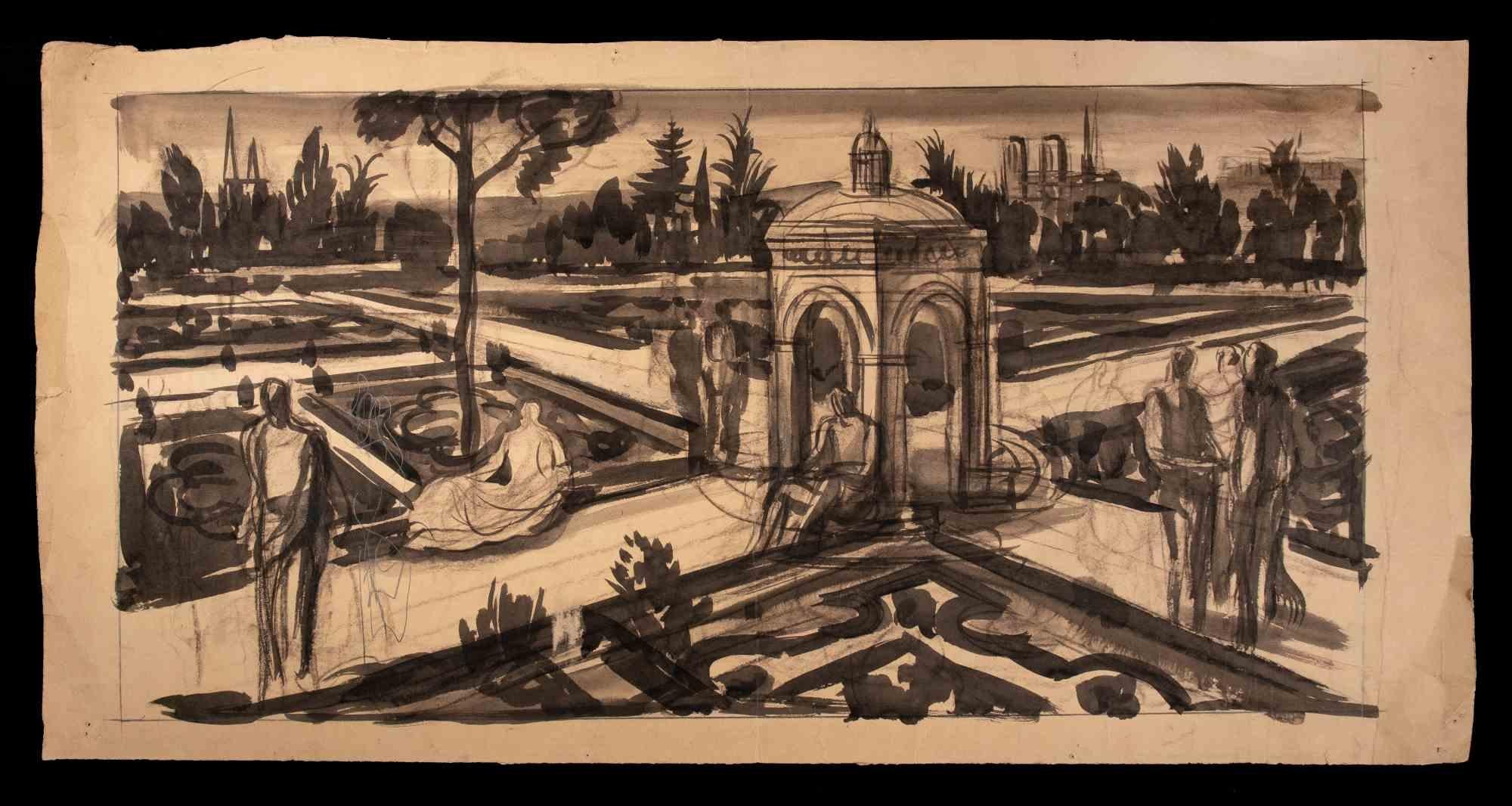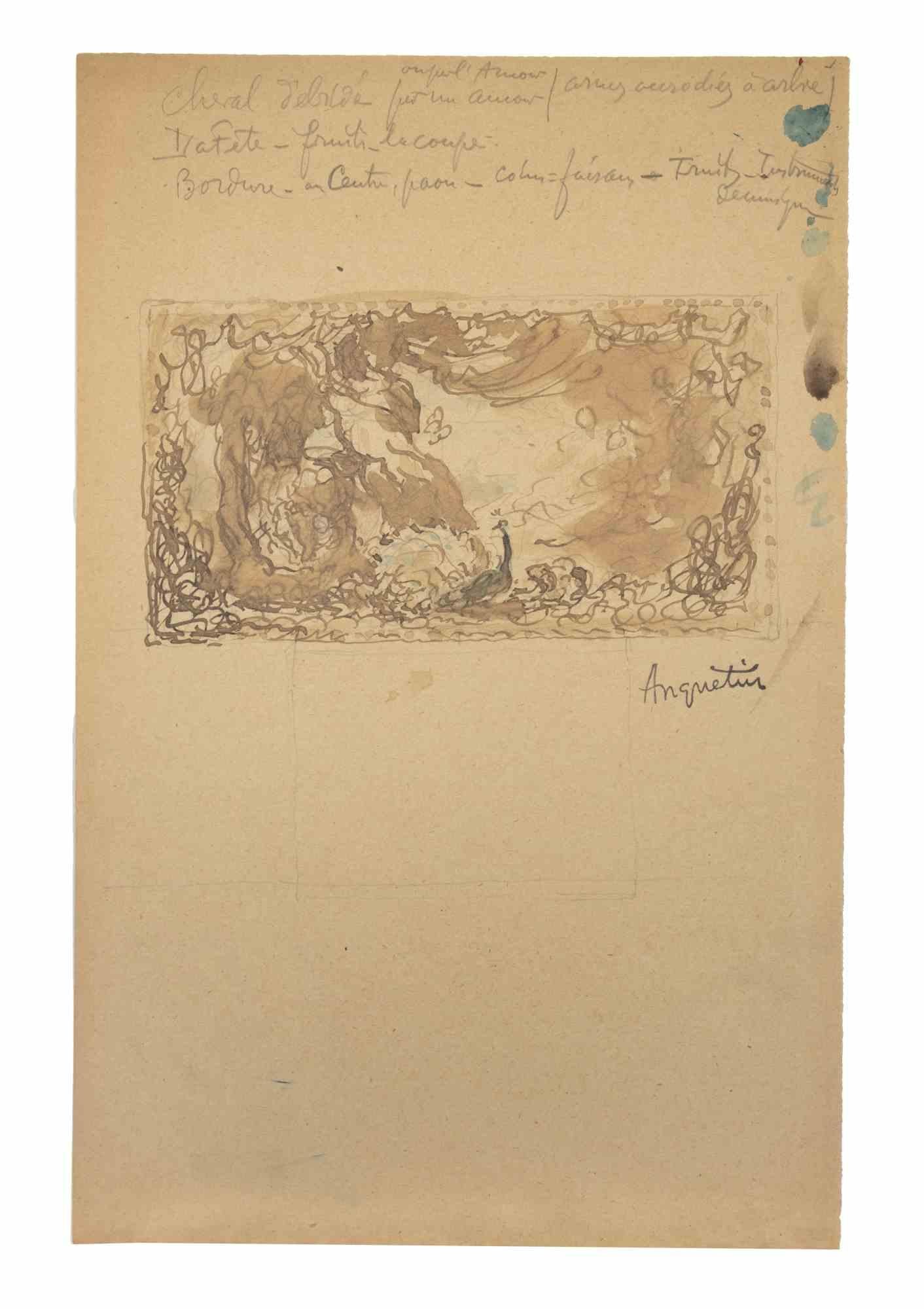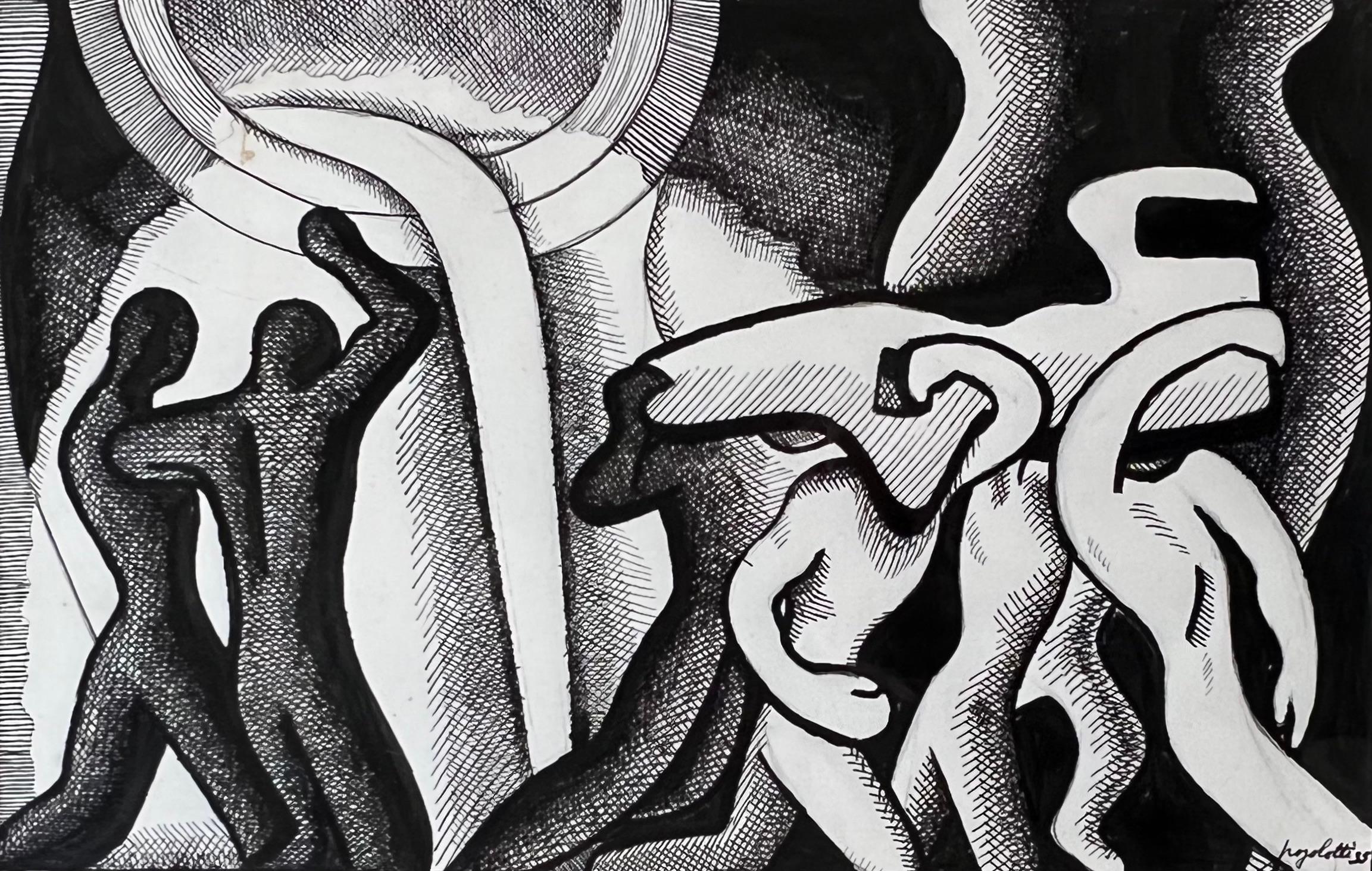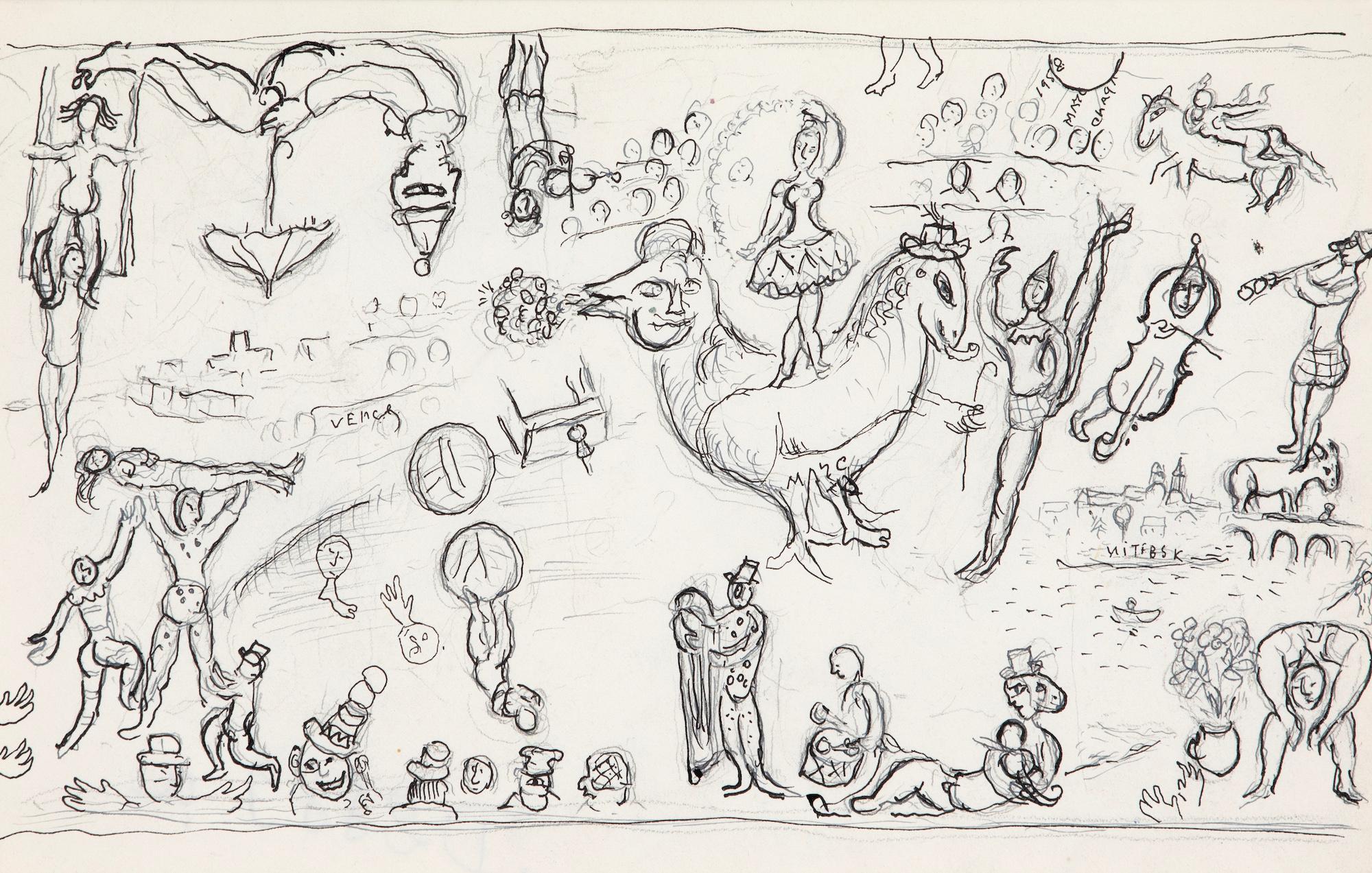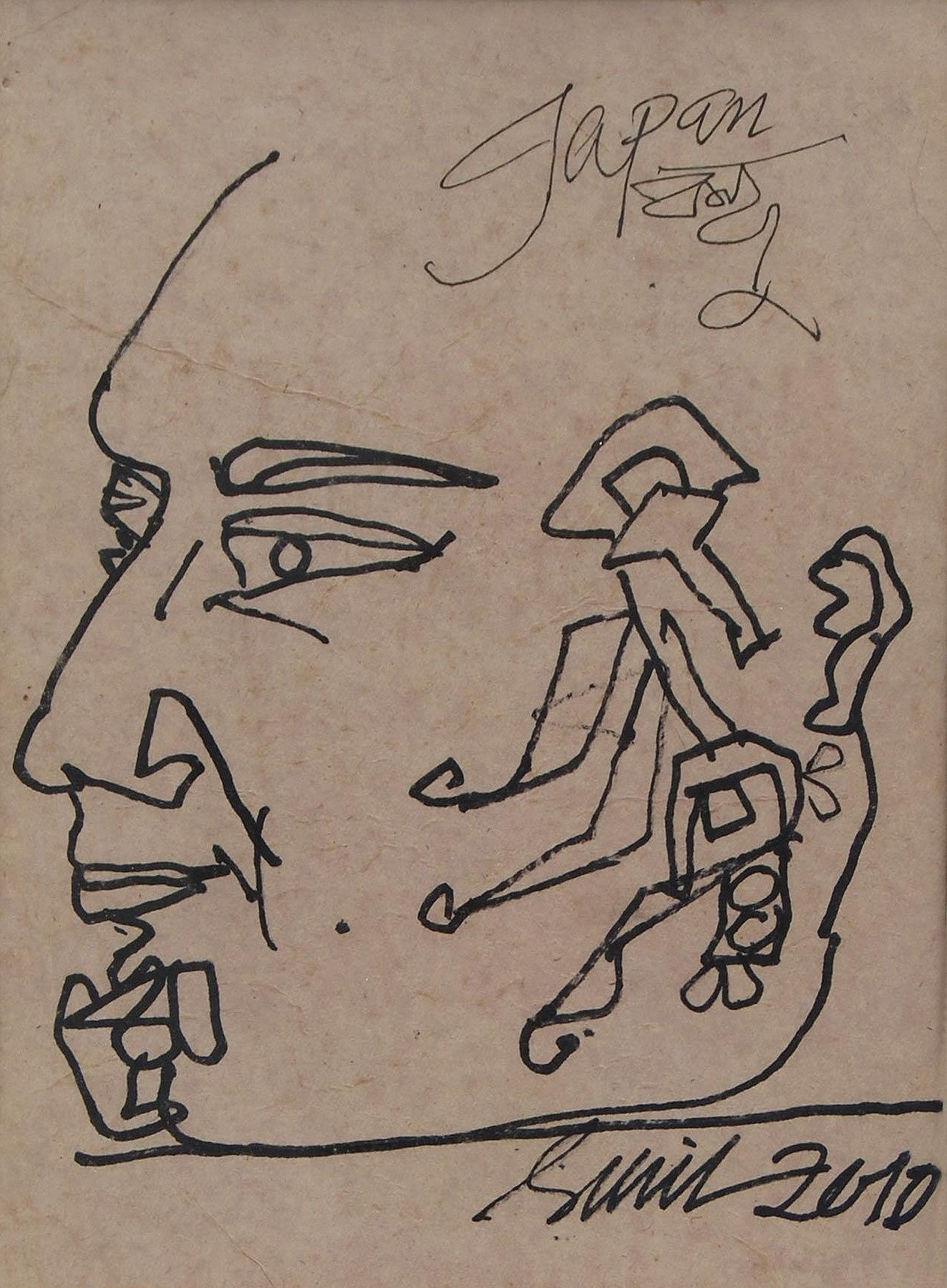Abraham WalkowitzModernist Drawing, Portrait of a Man1900
1900
About the Item
- Creator:Abraham Walkowitz (1878 - 1965, American)
- Creation Year:1900
- Dimensions:Height: 16 in (40.64 cm)Width: 13 in (33.02 cm)
- Medium:
- Movement & Style:
- Period:
- Condition:Measurements include frame.
- Gallery Location:Surfside, FL
- Reference Number:1stDibs: LU38211635602
Abraham Walkowitz
Abraham Walkowitz is perhaps best known for his watercolor studies of Isadora Duncan and the dance. However, Walkowitz laid claim to being the first to exhibit truly modernist paintings in the United States. After 1909, he became an intimate of Alfred Stieglitz's 291 Gallery, and while there became a participant in the debate over modern art in America. Walkowitz was an outspoken proponent of the continuous experimentation in the arts, which was his definition of modernism. As an artist, Walkowitz embodied the changing role of the modernist painter in the United States, as modernism moved from an avant-garde protest against established modes to become an accepted style and tradition.
Abraham Walkowitz was a Russian born, turn-of-the-century immigrant to the United States, who grew up in New York's Lower East Side. He first studied art at the Educational Alliance, the Cooper Union and the National Academy of Design. In 1906, he journeyed to Europe where he studied at the Académie Julian in Paris. Upon his return to the United States in 1907, he became a fully-fledged convert to modernism, and his first exhibit, at the Haas Gallery in that year, brought him a measure of notoriety as well as the attention of Stieglitz and other pioneers of non-objective art. In subsequent years, he became one of the most exhibited painters shown at the 291 Gallery, a fact which was also reflected in the pages of Stieglitz's polemical journal of modernism, camera work. As a result of this early attention, by the time of the Armory Show of 1913, to which Walkowitz contributed several paintings, his work was widely known to both fellow modernists as well as their opponents.
Walkowitz was clearly part of the new vocabulary of American art and criticism. During the 1920s and 1930s, as the first-generation modernists lost their revolutionary cast, and as American realism gained in favor, Walkowitz continued his experiments with form and line, especially in his series of Duncan studies. Although his paintings received less critical attention than they once had, Walkowitz was clearly one of the grand old folk of American modernism. During the depression, Walkowitz was politically active on behalf of unemployed artists supporting various new-deal initiatives in the arts. In the 1940s, Walkowitz gained national attention when he explored the varieties of the modernist vision in the form of an exhibit of 100 portraits of him by 100 artists. The result was widely discussed and was featured in Life magazine in 1944.
In 1945, Walkowitz traveled to Kansas, where he painted landscapes made up largely of strip mines and barns. This was his last venture in active painting — by 1946, glaucoma, which led to his eventual blindness, began to impair his vision and limit his ability to work. Walkowitz then turned to the preparation of a series of volumes of his drawings, designed to illustrate the development of modernism in the 20th century, and in so doing, established his role as a pioneer American modernist.
- ShippingRetrieving quote...Ships From: Surfside, FL
- Return PolicyA return for this item may be initiated within 3 days of delivery.
- Ink Drawing Man in Suit and Hat with NudeBy Jonathan ShahnLocated in Surfside, FLProvenance: Hinckley & Brohel Gallery Jonathan Shahn, Born 1938 has been making sculpture, drawings and prints of the human figure since the early 1960s. He teaches at the Art Studen...Category
20th Century American Modern Figurative Drawings and Watercolors
MaterialsPaper, Ink
- Vintage Israeli Bezalel School Drawing Family Playing, Dogs Puppies Kibbutz LifeBy Moshe AvniLocated in Surfside, FLMoshe Avni was born in 1937, in Kibbutz Kfar Blum in the Upper Galilee in Israel. Presently, he lives and paints in Jerusalem. During the years 1956-1957, he studied Painting and Graphic Arts in the Bezalel Art School in Jerusalem, supported by a Betzalel School Scholarship. He studied with and was guided by the painter Leo Roth, z”l (1914-2002), from Kibbutz Afikim. Moshe Avni has participated in Workshops and Courses in the framework of the Kibbutz Movement and the Israeli Artists’ Organization. He has received scholarships from both the Sharett Fund and from the Norman Fund. In 1979, Moshe Avni was accepted to the Israeli Artists’ Organization. Exhibitions 2011 In the Jerusalem House of Quality – 16-22 December 2011 2009 In the Neighborhood Center of Beit haKerem, Jerusalem 2003 In Moshav Batzra, Israel 1984 In the Artists’ Quarter, Rishon leZion, Israel 1979 In the House of Culture for Young People, Kfar Saba, Israel 1977 In the “New Gallery”, Tel Aviv, Israel 1973 In the “New Gallery”, Tel Aviv, Israel 1970 In “The House of Uri and Rami Nechushtan” in Ashdot Yaacov, Israel Horses & People, New Gallery, Tel Aviv 1965 Journalists House - Sokolov House, Tel Aviv, Israel Exhibitions of Young Artists in “House of Helena Rubenstein”, Tel Aviv, Israel Private Exhibitions in Jerusalem, Tel Aviv, and more. Group Exhibitions Kiryat Shmona 1957 Artists: Noemi Schindler...Category
1960s Modern Figurative Drawings and Watercolors
MaterialsPen, Paper, Ink
- Figures in the Forest, Rare Drawing, Israeli Modernist masterBy Itzhak DanzigerLocated in Surfside, FLYitzhak Danziger Genre: Expressionist Subject: People Medium: Ink Surface: Paper Dimensions w/Frame: 17" x 17" Yitzhak Danziger (Hebrew: יצחק דנציגר; 26 June 1916 – 11 July 1977) was an Israeli sculptor. He was one of the pioneer sculptors of the Canaanite Movement, and later joined the "Ofakim Hadashim" (New Horizons) group. orn in Berlin in 1916, Izhak Danziger moved to Palestine in 1923. From 1934-1937 Danziger studied at the Slade School of Fine Art, London. During the 1940s he worked in Paris with Zadkine and Brancusi. In the 1950s he exhibited in London at the Institute of Contemporary Art. He is considered to be one of Israel's most important sculptors. His work, which consists largely of environmental pieces, has been exhibited at the Hisrshhorn Museum and Sculpture Garden in Washington D.C. In 1969 Danziger was awarded the Sandberg Prize by the Israel museum. He died in 1977. When discussing Chariot II, Mordechai Omer compares it to a work of similar subject by Alberto Giacometti. He explains that Danziger, unlike Giacometti, removes the figure, leaving only the chariot itself. Omer eloquently explains that "The vehicle designed to serve the needs of the person inside is devoid of this human presence, with only the memories of its headlong downhill journeys leaving their mark in the parts of a half-ruined, half-standing chariot, allowing wide scope for the viewer's imagination. If Giacometti's chariots reminded him of hospital pharmacy wagons, Danziger's gleaming brass chariots...Category
Mid-20th Century Modern Figurative Drawings and Watercolors
MaterialsPaper, Ink
- Large Drawing of Boy by French Armenian Modernist Jean Jansem Ecole De Paris ArtBy Jean JansemLocated in Surfside, FLJean Jansem (Hovhannes Semerdjian) 1920-2013 Young Boy (sad young man) Hand signed lower left corner Provenance: Marble Arch Gallery NYC Measurements Image size: 25 by 18 inches, ove...Category
1960s Modern Figurative Drawings and Watercolors
MaterialsPaper, Ink
- Whimsical Fishing Illustration Cartoon 1938 Mt Tremblant Ski Lodge William SteigBy William Steig (b.1907)Located in Surfside, FLLighthearted Illustration of Outdoor Pursuits This one of a fisherman signed "W. Steig" Provenance: from Mrs. Joseph B. Ryan, Commissioned by Joe Ryan for the bar at his ski resort, Mount Tremblant Lodge, in 1938. Mont Tremblant, P.Q., Canada Watercolor and ink on illustration board, sights sizes 8 1/2 x 16 1/2 in., framed. In 1938 Joe Ryan, described as a millionaire from Philadelphia, bushwhacked his way to the summit of Mont Tremblant and was inspired to create a world class ski resort at the site. In 1939 he opened the Mont Tremblant Lodge, which remains part of the Pedestrian Village today. This original illustration is on Whatman Illustration board. the board measures 14 X 22 inches. label from McClees Galleries, Philadelphia, on the frame backing paper. William Steig, 1907 – 2003 was an American cartoonist, sculptor, and, in his later life, an illustrator and writer of children's books. Best known for the picture books Sylvester and the Magic Pebble, Abel's Island, and Doctor De Soto, he was also the creator of Shrek!, which inspired the film series of the same name. He was the U.S. nominee for both of the biennial, international Hans Christian Andersen Awards, as a children's book illustrator in 1982 and a writer in 1988. Steig was born in Brooklyn, New York in 1907, and grew up in the Bronx. His parents were Polish-Jewish immigrants from Austria, both socialists. His father, Joseph Steig, was a house painter, and his mother, Laura Ebel Steig, was a seamstress who encouraged his artistic leanings. As a child, he dabbled in painting and was an avid reader of literature. Among other works, he was said to have been especially fascinated by Pinocchio.He graduated from Townsend Harris High School at 15 but never completed college, though he attended three, spending two years at City College of New York, three years at the National Academy of Design and a mere five days at the Yale School of Fine Arts before dropping out of each. Hailed as the "King of Cartoons" Steig began drawing illustrations and cartoons for The New Yorker in 1930, producing more than 2,600 drawings and 117 covers for the magazine. Steig, later, when he was 61, began writing children's books. In 1968, he wrote his first children's book. He excelled here as well, and his third book, Sylvester and the Magic Pebble (1969), won the Caldecott Medal. He went on to write more than 30 children's books, including the Doctor DeSoto series, and he continued to write into his nineties. Among his other well-known works, the picture book Shrek! (1990) formed the basis for the DreamWorks Animation film Shrek (2001). After the release of Shrek 2 in 2004, Steig became the first sole-creator of an animated movie franchise that went on to generate over $1 billion from theatrical and ancillary markets after only one sequel. Along with Maurice Sendak, Saul Steinberg, Ludwig Bemelmans and Laurent de Brunhofff his is one of those rare cartoonist whose works form part of our collective cultural heritage. In 1984, Steig's film adaptation of Doctor DeSoto directed by Michael Sporn was nominated for the Academy Award for Best Animated Short Film. As one of the most admired cartoonists of all time, Steig spent seven decades drawing for the New Yorker magazine. He touched generations of readers with his tongue–in–cheek pen–and–ink drawings, which often expressed states of mind like shame, embarrassment or anger. Later in life, Steig turned to children's books, working as both a writer and illustrator. Steig's children's books were also wildly popular because of the crazy, complicated language he used—words like lunatic, palsied, sequestration, and cleave. Kids love the sound of those words even if they do not quite understand the meaning. Steig's descriptions were also clever. He once described a beached whale as "breaded with sand." Throughout the course of his career, Steig compiled his cartoons and drawings into books. Some of them were published first in the New Yorker. Others were deemed too dark to be printed there. Most of these collections centered on the cold, dark psychoanalytical truth about relationships. They featured husbands and wives fighting and parents snapping at their kids. His first adult book, Man About Town, was published in 1932, followed by About People, published in 1939, which focused on social outsiders. Sick of Each Other, published in 2000, included a drawing depicting a wife holding her husband at gunpoint, saying, "Say you adore me." According to the Los Angeles Times, fellow New Yorker artist...Category
1930s American Modern Figurative Drawings and Watercolors
MaterialsIndia Ink, Watercolor, Illustration Board
- Costume Stage Drawing Medieval Jester or Harlequin Figure Watercolor PaintingLocated in Surfside, FLStage costume drawing in the style of Ballet Russe. unsigned older piece.Category
Early 20th Century Modern Figurative Drawings and Watercolors
MaterialsInk, Watercolor
- Jonas by Marc Chagall - School of Paris, Russian ArtistBy Marc ChagallLocated in London, GB*PLEASE NOTE UK BUYERS WILL ONLY PAY 5% VAT ON THIS PURCHASE. Jonas by Marc Chagall (1887-1985) Indian ink on paper 35.6 x 26.9 cm (14 x 10 ⅝ inches) Signed with Estate stamp lower ...Category
1950s Modern Figurative Drawings and Watercolors
MaterialsIndia Ink, Paper
- The Bird - Drawing by Louis Anquetin - Early 20th CenturyBy Louis AnquetinLocated in Roma, ITThe Bird e is an ink drawing on paper realized in the early 20th Century by Louis Anquetin (1861-1932). Hand-signed on the lower. Good condition with slight foxing. Louis Émile An...Category
Early 20th Century Modern Figurative Drawings and Watercolors
MaterialsPaper, Ink
- Temple in the Garden - Drawing - Early 20th CenturyLocated in Roma, ITTemple in the Garden is an original artwork, pencil, watercolor and charcoal on paper. Is not signed and dated but we can attribute the period early 20th Century. It's an evocative...Category
Early 20th Century Modern Figurative Drawings and Watercolors
MaterialsInk, Paper
- "Steel Factory" Cuban Mid 20th Century Modern Drawing WPA Latin Art IndustrialLocated in New York, NY"Steel Factory" Cuban Mid 20th Century Modern Drawing WPA Latin Art Industrial Ink on paper. 12 x 19 inches. Pogolotti lived in Paris in the 1930s. The drawing here comes from the collection of his Parisian ophthalmologist, Dr. Prokopenko . Unfortunately, the artist lost his eyesight in 1938. Marcelo Pogolotti (1902–1988) was a Cuban painter...Category
1930s Modern Figurative Drawings and Watercolors
MaterialsPaper, Ink
- Esquisse pour "Commedia dell'arte" by Marc Chagall - DrawingBy Marc ChagallLocated in London, GB*THIS PRICE INCLUDES 5% IMPORT DUTY APPLICABLE IF THE WORK REMAINS IN THE UK ONLY. Esquisse pour "Commedia dell'arte" by Marc Chagall (1887-1985) India ink, pen and pencil on paper...Category
1950s Modern Figurative Drawings and Watercolors
MaterialsIndia Ink, Paper, Pen, Pencil
- Head, Japan Bandhu, Ink on Paper, Black, Brown by Indian Artist "In Stock"By Sunil DasLocated in Kolkata, West BengalSunil Das - Head - 9.25 x 7 inches (unframed size) Ink on Paper Inclusive of shipment in ready to hang form. Sunil Das (1939-2015) was a Master Modern Indian Artist from Bengal. Ext...Category
2010s Modern Figurative Paintings
MaterialsInk, Paper
